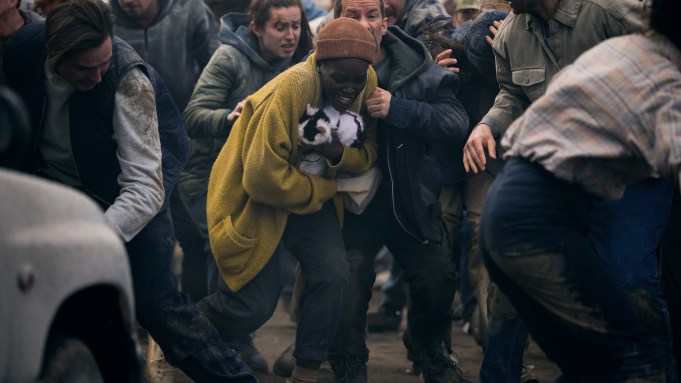
Gareth Gatrell
“A Quiet Place” has become a horror franchise with few equals.
The third installment in Paramount’s post-apocalyptic series, “A Quiet Place: Day One,” has surpassed expectations with $53 million domestically and $98 million worldwide in its box office debut. It has the best start of the three films, ahead of the 2018 original “A Quiet Place” ($50 million to open) and the 2021 sequel, “A Quiet Place Part II” (a $48 million debut, but that happened during COVID). The enduring appeal of the trio of films, with the most recent entry serving as an origin story, indicates that “A Quiet Place” has enough star power to fill seats at multiplexes based on the strength of its name. It joins the company of other big horror properties like “The Conjuring,” “Paranormal Activity” and “Insidious,” all of which remain popular but have seen diminishing returns over numerous sequels and spinoffs.
“There have been bigger horror movies,” says David A. Gross, who runs the film consulting firm Franchise Entertainment Research, pointing to adaptations of Stephen King’s “It” (the first opened to $123 million and grossed $704 million; the sequel opened to $91 million and earned $473 million) as well as last October’s “Five Nights at Freddy’s” (the video game adaptation debuted to $80 million and ended its run with $291 million). Still, Gross adds, “no series has been as consistent after three movies as this one. The hook — otherwise stay calm – will carry it indefinitely into the future.
“A Quiet Place Part III” is already in the works, and it’s rumored to be a direct sequel to the 2021 installment. Details, including the involvement of franchise creator John Krasinski and stars Emily Blunt, Millicent Simmonds and Noah Jupe, have not been confirmed. But given the continued interest in the property, Gross isn’t wrong to expect another commercial success.
The triumph of “Day One,” however, is remarkable because spinoffs rarely live up to sequels at the box office. “Furiosa: A Mad Max Saga” missed its target in May, and while last year’s “The Hunger Games: The Ballad of Songbirds and Snakes” was a commercial success, its ticket sales fell short of the original series.
Prequels are a tougher sell because moviegoers usually know what happens later in the story. They’re especially difficult when they don’t feature stars from the original. But “A Quiet Place: Day One” defied the odds and expanded its audience even though Blunt and Krasinski, who propelled the first two films to box-office glory, didn’t return for this entry. The series maintained its pedigree by starring Oscar winner Lupita Nyong’o alongside “Stranger Things” actor Joseph Quinn in the story set at the start of an alien invasion in New York City. “Pig” filmmaker Michael Sarnoski took over for Krasinski, who contributed to the story and served as a producer.
Analysts and critics believe that “A Quiet Place: Day One” was a box office success because it managed to justify its existence and feel worthy of an entry in the franchise. Another factor in its favor is the film’s genre-transcending quality. It’s more science fiction than slasher, so while it’s scary (sure), it’s not scary enough to turn off peripheral fans of the genre.
“It didn’t seem like a scam attempt, but rather part of the story that needed to be told,” said Paul Dergarabedian, a senior analyst at Comscore.
Paramount’s domestic distribution president Chris Aronson said supporters of the property had asked the studio for an origin story about the creepy monsters that eventually forced the population to hide from the terrifying, sound-hunting creatures.
“We listened to the fans to find out what they were looking for,” Aronson says. “Giving them a new city as a setting and new characters helped broaden the audience.”
Dergarabedian believes that these films are especially fun to watch in crowded theaters, because silence is the key to survival. Like its predecessors, “Day One” contains minimal dialogue and lots of tense, thrilling action sequences. This means that inside the room, the slightest gasp, scream, or sip from a cup of soda can echo throughout the room.
“The community experience makes it electrifying,” Dergarabedian says. “The audience is afraid to eat popcorn or make noise.”
“A Quiet Place” is one of the highest-rated horror franchises. Moviegoers and critics alike responded enthusiastically to the latest PG-13 film, which earned a solid B+ CinemaScore and 84% on Rotten Tomatoes. Opening weekend crowds skewed slightly male (men made up 53% of ticket buyers), while millennials and Gen Z were out in force with 55% of patrons ages 18 to 34. Many of those viewers chose to watch “Day One” on the biggest screen possible, with nearly 40% of domestic revenue coming from premium screens like Imax and Dolby.
“Critics and audience ratings are down slightly from ‘A Quiet Place Part II,’ but still excellent for the genre,” Gross says.
There’s one potentially ominous sign as the franchise inevitably expands; the budgets keep getting bigger. The first film, which became a sleeper hit with $340 million worldwide, cost $17 million. The sequel, another winner with $297 million worldwide, easily moved into mid-budget territory with its $61 million price tag. “A Quiet Place: Day One” was slightly more expensive, with a $67 million production. Given its early global ticket sales, the prequel is well-prepared for its theatrical run. But Paramount needs these films to remain mid-budget offerings to justify ever-increasing returns to this dystopian universe.
After all, the only thing scarier than merciless sound-seeking monsters is shrinking profit margins. At least, if you’re the studio paying the bill.